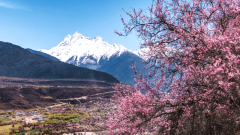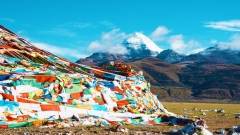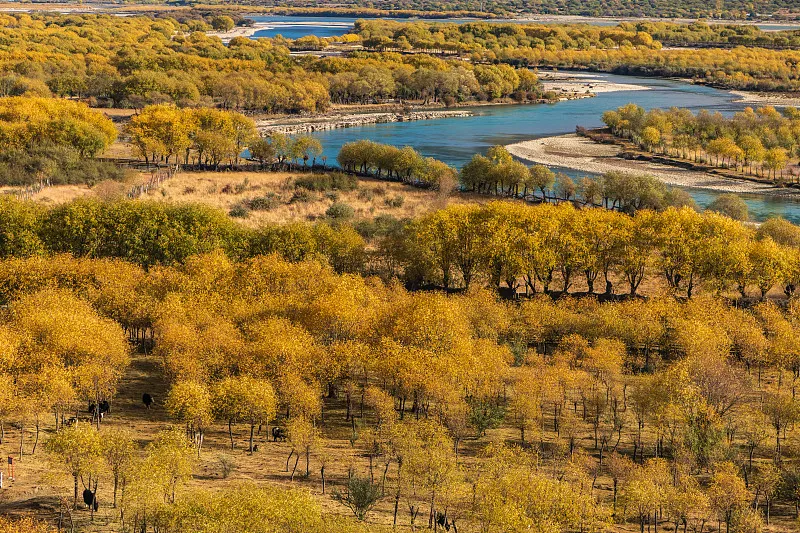High on the Tibetan Plateau, surrounded by snow-capped mountains and vast stretches of grassland, lies Yamdrok Lake (Yamdrok Yumtso), one of Tibet’s three great sacred lakes. Known as the “Turquoise Lake,” it captivates visitors with its surreal, ever-changing shades of blue, green, and even golden hues. To the naked eye, Yamdrok seems alive, shifting colors throughout the day and across the seasons. What causes these transformations, and why is the lake so revered? Let’s uncover the secret of Yamdrok Lake’s changing colors.
A Sacred Jewel of Tibet
Yamdrok Lake sits at an altitude of 4,441 meters (14,570 feet) and stretches more than 72 kilometers in length. From above, its shape resembles a coiling scorpion or an elegant fan, with arms of water winding between mountain ridges. Alongside Lake Namtso and Lake Manasarovar, Yamdrok is considered one of Tibet’s holiest lakes.
For Tibetans, Yamdrok is believed to be the earthly embodiment of a goddess and a spiritual source of life. Pilgrims travel from near and far to circumambulate the lake, seeking blessings for fertility, longevity, and good fortune.
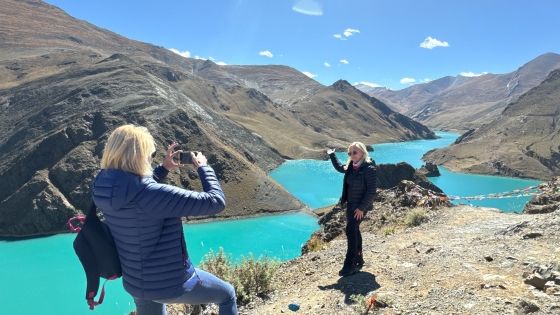
Yamdrok Lake
The Science Behind the Color Changes
The changing colors of Yamdrok Lake are not simply a trick of the imagination but a natural phenomenon shaped by its environment. Several factors contribute:
-
Mineral-Rich Waters: The lake contains high concentrations of minerals, especially copper and calcium carbonate, which reflect light differently.
-
Sunlight and Angle: As the sun rises and sets, the angle of light changes, making the water appear turquoise, emerald, or sapphire blue.
-
Depth Variations: Shallower areas near the shore often appear lighter blue or green, while deeper sections turn a rich navy or indigo.
-
Seasonal Influence: In summer, glacial meltwaters add a lighter, milky hue, while in autumn the lake reflects a clearer turquoise tone. During winter, parts of the lake may freeze, creating silvery or golden shades under the sun.
This interplay of geology, climate, and light gives Yamdrok its mesmerizing, shifting palette.
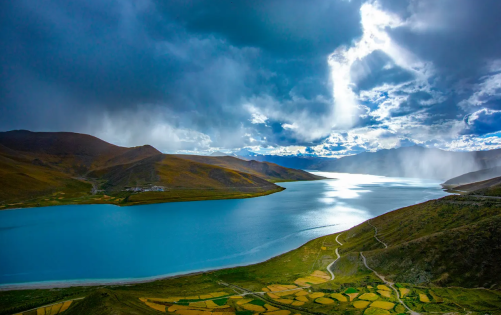
Cultural and Spiritual Meanings
For Tibetans, the lake’s color changes are not just a scientific curiosity but a divine manifestation. Many believe the lake reflects the moods of deities or signals blessings to the surrounding land. In some traditions, Yamdrok is said to be connected to the soul of Tibet itself—if the lake were to ever dry up, Tibet’s prosperity would vanish with it.
Monks from nearby monasteries often conduct rituals on its shores, using the lake’s water in ceremonies for purification and healing. Farmers also pray at Yamdrok for good harvests, while herders ask for the health of their livestock.
Best Viewing Spots Around Yamdrok
To truly appreciate the lake’s colors, visitors often stop at several famous viewpoints:
-
Kamba La Pass (4,797 m): Perhaps the most iconic viewpoint, offering a panoramic vista of the lake against the backdrop of snow-covered peaks. From here, Yamdrok resembles a turquoise ribbon winding through the mountains.
-
Shannan Side Villages: Small villages along the shore allow visitors to see the lake at eye level, where its shimmering reflections contrast with the green fields.
-
Samding Monastery: Perched above the lake, this monastery not only offers stunning views but also carries spiritual importance as it was historically led by a female reincarnated lama.
-
On the Road to Gyantse: The scenic drive from Lhasa to Gyantse skirts along Yamdrok’s edge, with multiple pull-over points for photography.
Travel Tips for Visiting Yamdrok
If you are planning a trip to Yamdrok, here are some practical tips:
-
Best Time to Visit: April to October offers the clearest skies and most vibrant colors. In winter, although colder, the frozen surface creates a magical atmosphere.
-
Transportation: Most travelers visit as part of the Lhasa–Gyantse–Shigatse route. The journey from Lhasa takes about three hours by car.
-
Altitude Precautions: At over 4,400 meters, the air is thin. Move slowly, stay hydrated, and avoid strenuous activity if you’re not acclimatized.
-
Photography Tips: Morning and late afternoon light bring out the richest colors. A polarizing filter can help capture the lake’s shifting tones.
Yamdrok Lake in Local Life
Beyond its beauty, Yamdrok sustains life in the region. It is home to a variety of fish species, which provide food for local communities. Surrounding grasslands support herders who graze yaks and sheep along its shores.
The lake also plays a role in Tibetan religious life. Pilgrims walking the lake’s circuit believe that completing the journey will purify negative karma. Festivals are sometimes held on its banks, where locals gather for picnics, horse races, and traditional songs.
The Lake and Hydropower Controversy
In modern times, Yamdrok has also become a site of controversy. A hydropower station was built beneath the lake in the 1990s, sparking debate about its environmental and spiritual impact. While it provides electricity to Lhasa and nearby towns, many Tibetans remain concerned about the ecological balance of their sacred lake. This tension illustrates the challenges of preserving natural heritage while meeting modern needs.
Why Yamdrok Feels Different from Any Other Lake
Travelers often remark that Yamdrok Lake leaves a deep emotional impression. Its vastness, silence, and shimmering waters create a sense of otherworldliness. Standing on its shores, one feels both small in the face of nature’s grandeur and deeply connected to the spiritual traditions of Tibet.
Unlike many tourist destinations, Yamdrok is not just a scenic attraction—it is a living part of Tibetan culture, revered by locals and cherished by pilgrims.

Conclusion
Yamdrok Lake is more than a beautiful stretch of water. Its changing colors tell the story of nature’s delicate balance, influenced by sunlight, minerals, and altitude. For Tibetans, the shimmering shades reflect spiritual blessings, linking the land, its people, and the divine.
Whether you are drawn by its scientific wonders, its sacred aura, or its sheer beauty, Yamdrok Lake offers a once-in-a-lifetime experience. Watching its waters shift from turquoise to emerald to golden light, you will understand why Tibetans call it one of their most precious jewels.






